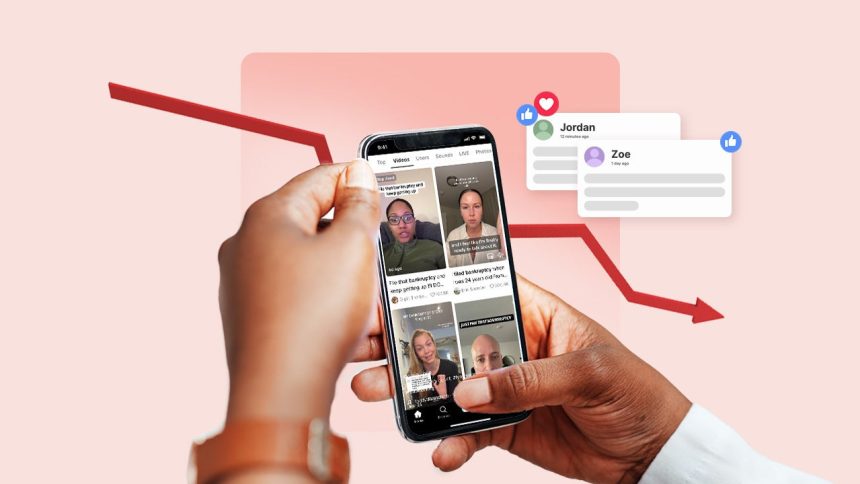When Whitney Catalano filed for Chapter 7 bankruptcy in 2022, she was self-employed, living in an apartment she couldn’t afford and carrying $60,000 in credit card and personal loan debt. For her, bankruptcy looked like freedom.
“I felt very overwhelmed by money,” she says. “I wanted to clear myself of this chapter and really restart from a clean slate.”
Catalano is one voice in a chorus of TikTok accounts lauding bankruptcy. It goes something like this: People in their 20s and 30s film their stories of filing for bankruptcy, calling it the best decision they ever made. Or in modern meme talk: “‘You look happier.’ Thanks, I filed for bankruptcy.”
Now 32 years old, Catalano says she’s built a good credit score and been able to secure apartments and new credit cards that she pays off. She owes no debt.
Bankruptcy might sound like a golden ticket out of debt, but there are consequences. And TikTok certainly shouldn’t be your primary source of financial advice. I talked to a lawyer and a credit counselor to learn about alternatives to bankruptcy and what to know before filing.
Bankruptcy filings are on the rise
Data shows the TikTok trend is indeed playing out in real life.
While the U.S. Bankruptcy Courts reports overall bankruptcy filings are much lower today than in the early 2000s — for example, around 310,600 Chapter 7 filings in 2024 versus 1,139,600 in 2010 — numbers are up since the Fed raised rates in 2022.
Student loan payments are due again. Inflation remains stubbornly high and holiday spending is around the corner. The job market is cooling. Housing costs are up.
Janet Swope, credit counselor of 30 years, runs an agency that offers a state-approved course for people considering bankruptcy. Her client list grows each year, and that includes a recent uptick in younger clients.
This bankruptcy lawyer offers alternatives to filing
Bankruptcy isn’t to be taken lightly. Even though it’s Michael DuPont’s job to help clients file for bankruptcy, he starts by going over alternatives.
A LegalShield provider attorney at Wagner, Falconer & Judd, Ltd, DuPont saw more reluctance to file bankruptcy when he started practicing law 35 years ago. “It is more socially acceptable today,” he says. Still, here’s what he suggests trying before filing.
You might be able to negotiate debt settlement with your lender, either by yourself or with the help of a credit counselor or debt settlement company. There are even AI tools that will negotiate for you. Negotiation can lead to a smaller lump-sum payment, lower interest rate or forbearance.
Or, you could get a lower interest rate and relief from debt collectors with a debt management plan through a credit counseling agency. In this situation, a credit counselor will negotiate with your lenders for you. Then, you’ll make a single monthly payment to the credit counseling agency, who will repay the lenders on your behalf.
These solutions can be quicker, less expensive and have less impact on your credit.
Bankruptcy doesn’t come without risks
Bankruptcy can offer short-term relief with long-term aftermath.
First off, it might cost more than you think to file. The filing fee starts at $313, but hiring an attorney can cost $1,000 to more than $5,000. You also might have to pay for the required education courses.
The two types of bankruptcy for individuals are Chapter 7 and 13. Chapter 7 requires you to sell certain property to pay off creditors, before wiping away the remainder of your unsecured debt. Chapter 13 lets you make a single monthly payment to a trustee under a new repayment plan lasting 3 to 5 years. And you get to keep your property.
Then there’s the matter of credit. Catalano says her credit score increased after filing when her debts were cleared and credit utilization dropped. But a Chapter 7 bankruptcy stays on your credit report for up to 10 years, and a Chapter 13 bankruptcy for up to 7 years. That means any time you apply for an apartment lease, new credit card, car loan or mortgage, the lender may ask about the mark or deny you automatically. And even if you get approved, you might end up with a very high interest rate or other suboptimal loan terms.
Your assets can also be at risk, depending on which type of bankruptcy you file. Chapter 7 requires you to sell non-exempt assets for cash to repay lenders. Exemptions vary by state, but your home, car and belongings could all be fair game. Chapter 13 lets you keep your assets as long as you make the payments decided on in court.
Finally, know that certain types of debt like child support, taxes and student loans can’t be discharged in bankruptcy.
To file or not to file, that is the question
Friends, TikTokers and even credit counselors can’t tell you whether or not to file for bankruptcy. For legal advice, talking to a lawyer is your best bet.
If you’ve considered alternative options but bankruptcy is what’s left on the table, here’s how DuPont suggests proceeding.
First, consider the type of debt you have. Unsecured debt, like credit cards and medical bills, can be eliminated with Chapter 7. But secured debt, like a mortgage or car loan, means your assets can be taken away unless you work out a new repayment plan with Chapter 13.
Then there’s the means test. If your income is below the state’s median income for your household size or your expenses leave you with little disposable income, you can qualify for Chapter 7 bankruptcy. If you fail the test, you’d need to consider Chapter 13.
Here are a couple examples from DuPont of when bankruptcy could make sense:
- Chapter 7: You don’t have many secured assets, like a home, and you have large medical or credit card bills on which the lender’s unwilling to negotiate.
- Chapter 13: You bought a home at a rate you can’t afford and are now faced with foreclosure.
Don’t feel guilty, says a credit counselor
Swope says there’s one thing her bankruptcy clients have in common — remorse.
During the first consultation, clients want to apologize for their debt spiral or mortgage foreclosure. “I try to get people to understand there’s no guilt,” she says. “Things happen.” Swope tells me the common culprits of bankruptcy are medical debt, job loss, divorce and credit card debt from basic expenses that income can’t cover.
Swope helps clients know their rights and crunch their numbers. Most don’t have a complete picture of their income compared to expenses and total debt. Her clients’ credit reports are also usually in bad shape.
“They need to rebuild somewhere,” she explains. “So are they going to [file] a bankruptcy and rebuild, or are they going to rebuild the credit report that’s already really damaged?”
A look at life after bankruptcy

Catalano decided the consequences of bankruptcy were worth it for her. “I couldn’t see myself spending the next 3 to 5 years still in the debt cycle, trying to pay it down,” she says.
After filing, she says she was able to rent from a private landlord by explaining her situation and showing her positive history of rent payments. And she was approved for a credit card from her bank, which allowed her to start rebuilding credit.
In the meantime, Catalano’s working full-time again and has adopted new habits to stay out of debt. She tracks her budget monthly. She plans ahead for large purchases. And after cutting expenses while filing for bankruptcy, she’s kept her costs low. “My spending and saving always perfectly fit in my income,” she says.
If you decide to file, you’ll need to rebuild credit after bankruptcy. Be prepared to make future credit card and loan repayments on time and in full, and stick to a budget to avoid racking up more debt.
But remember, “Time takes care of things,” Swope says. The further away you get from filing, the less it hurts your future.
So no, bankruptcy isn’t a get out of jail free card. There are monetary and opportunity costs to weigh against the relief of a $0 debt balance. For some young people, bankruptcy may be the first step toward a fresh start. For others, it may be only one of several better options. Only you — and a legal professional — can decide what’s right for your financial future.
Why we ask for feedback
Your feedback helps us improve our content and services. It takes less than a minute to
complete.
Your responses are anonymous and will only be used for improving our website.
Help us improve our content
Read the full article here
















